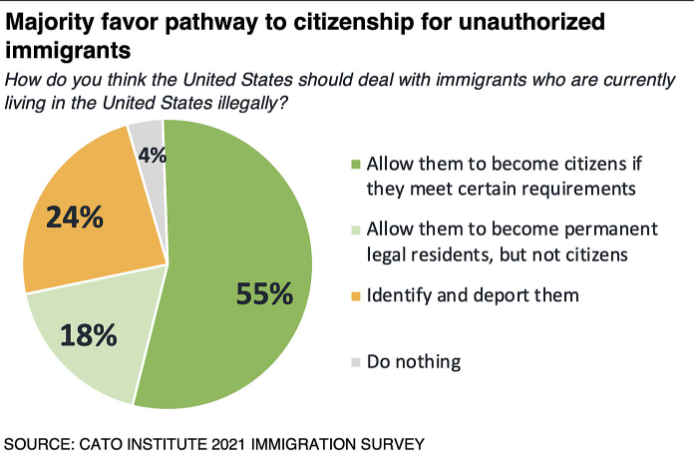New Cato Survey Helps Reframe the Debate Over Legal Immigration
 My colleagues Emily Ekins and David Kemp just released an excellent new survey on how Americans view immigration and identity. We all worked together on crafting the questions for several months prior to publication and the results are very interesting. Below are some findings and some lessons that folks who support immigration should take to heart.
My colleagues Emily Ekins and David Kemp just released an excellent new survey on how Americans view immigration and identity. We all worked together on crafting the questions for several months prior to publication and the results are very interesting. Below are some findings and some lessons that folks who support immigration should take to heart.
First, the survey shows that most people know almost nothing about immigration. Even basic facts elude them. About 14 percent of the U.S. population is foreign‐born but the average respondent thinks that 40 percent of the country’s population is foreign‐born. Immigrants were the most likely to think that the immigrant population of the United States is high, estimating that 56 percent of the country is foreign‐born, while third generation and higher Americans estimated 36 percent.
The differences likely result from where the respondents reside in the United States. Immigrants live close to other immigrants and native‐born Americans live close to other native‐born Americans. For instance, about 27 percent of California’s population is foreign‐born compared to just 1.5 percent in West Virginia. Those who live closer to other immigrants are probably more likely to overestimate the immigrant percentage of the population. Using those two states as examples, immigrants in California overestimated the foreign‐born share of the population by about a factor of two, while third generation and higher Americans in West Virginia were off by a factor of 24. Regardless, native‐born Americans and immigrants both overestimate the share of immigrants.
Second, focusing on understandable metrics when communicating how the legal immigration system functions is more effective. Americans can better conceptualize the handful of years it takes to wait for a green card than the borderline abstract large quantity of visas issued per year. For example, one of the survey questions asked how long it should take to immigrate to the United States. Eighty percent of respondents said that it should take five years or less to immigrate, and they may have chosen that number because the question prompted them with a mention of a five‐year average. However, 52 percent of respondents said it should take less than five years. However, responses to another question revealed that 61 percent of respondents said they wanted fewer than one million immigrants a year – probably because one million is a large and abstract number that is difficult to visualize even though it’s a relatively small number of people compared to the roughly 330 million people living in the United States. By comparison, everybody understands what five years feels like and 80 percent of respondents answered that immigrants should wait five years or less for a green card. One lesson is that we should talk about immigration restrictions in terms of waiting times rather than numbers of visas. On the policy side, a maximum wait time for a visa without regard to the numerical caps would increase the number of visas issued without increasing the numerical caps on paper and be more rhetorically appealing. Fortunately, Cato proposed just such a reform in 2020.
Third, Americans care much less about job protectionism than we all thought. Two‐thirds of respondents said that businesses should be “allowed to hire whoever they believe is best qualified for the job regardless of nationality.” This is great news because wage and job‐protection regulations are responsible for a large percentage of the regulatory costs for sponsoring immigrants for employment‐based green cards and other temporary work visas such as the H-1B, H-2A, and H-2B. Removing those regulations would face less popular backlash than many of us assumed.
Fourth, most Americans think that restrictive immigration laws cause illegal immigration. Forty‐one percent said illegal immigration is caused by the legal immigration system being too restrictive and 19 percent said illegal immigrants were ineligible to apply. Most respondents are primed to understand that restrictions and government bureaucracy are the causes of illegal immigration.
Fifth, 56 percent said that simplifying the legal immigration process is a better way to deal with illegal immigration than building a border wall or increasing border security. This is incredibly good news for those of us who want to expand and liberalize legal immigration. Some findings in the field of political psychology suggest otherwise, that perceptions of chaos along the border influence voters to oppose immigration liberalization. Apparently, most people see chaos and their instinct is to support more enforcement and government control rather than liberalization. This creates a Catch‐22 because the only way to get sustainable control over the border is through liberalization but liberalization can only be politically sustainable if voters think the border is under control. On the contrary, this survey result indicates that respondents are more open to liberalization as a means of border control than the political psychology literature suggests.
There are many other fascinating findings in this Cato survey on immigration and identity and I recommend that you read and digest it all. However, the above findings are those that we will seek to most incorporate into our work.








